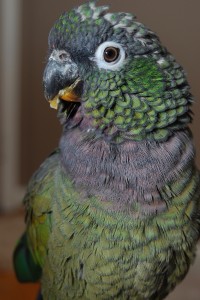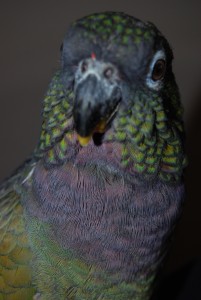Stopping Parrot Biting Without Force
NOTE: I have a new pet behavior blog. Please visit http://www.SoMuchPETential.com/blog. Thanks!
Dreyfuss is a bird who – if I’d let her – would spend her entire day sitting next to me or on me, frequently with her head down for rubs. So how was it that this sweet girl (who actually may be a boy but I’ve never had her sexed) would lung at my bare arm, and even bite it, when I’d put my arm in front of her body before asking for a ‘step up’ from her inside cage perch?
My education in behavior has taught me that biting doesn’t just ‘occur’ in a vacuum, and that before that aggressive behavior happens, a bird behaves with nonaggressive body language (such as dilated eyes, feathers fluffed) to let me know my arm is not wanted in its space. If I get bitten it is because I did not pull my arm away when the bird dilated its eyes or fluffed its feathers, causing the bird to need to escalate its behavior.
Yes, I know that. But I had been watching Dreyfuss’ body language and I just couldn’t see it. One second her body language was telling me she was eager to step up and the next split second she’d lunge.
My turning point came the moment I had written an email to a trainer I know. In it, I told her Dreyfuss’ behavior was ‘unpredictable’. I hit send and then had a WOAH moment. Hold on here, Lisa. You know better than that. And you have the skills to solve this without the use of force and set both you and Dreyfuss up for success.
Applied behavior analysis is a systematic approach to solving behavior problems by changing the environment in which the behavior occurs. It involves looking at the very specific behavior (such as a bird biting or screaming) and the related environmental context that signals and reinforces it. We ask, “What happened *immediately* prior to the behavior (antecedent) to set the whole ball rolling?“ And, “What happened *immediately* after the behavior to reinforce it (consequence)?“
There you have it…the A (antecedent), B (behavior), and C (consequence)’s.
So, let’s look at the ABC’s of this situation.
A(antecedent): Lisa puts hand on cage door
B (behavior): Dreyfuss either rocks from foot to foot or with slight movement
C (consequence): Lisa opens cage door
A: Lisa moves arm to Dreyfuss saying ‘step up’
B: Dreyfuss lunges or bites
C: Lisa removes hand
Prediction: Dreyfuss will lunge or bite more to get Lisa to remove her hand
I know, this doesn’t make sense for a bird that, once is on me, could live there. But obviously there is something about my arm being put in front of her that she didn’t want to have happen. How do I know? Because her behavior of biting/lunging continued and got more frequent.
The thing about studying behavior is that I don’t need to know what Dreyfuss was thinking. I only need to know that the behavior had a function for  her in her environment and I can then modify the environment to modify the behavior. I like to think about it as teaching new skills.
her in her environment and I can then modify the environment to modify the behavior. I like to think about it as teaching new skills.
So, what did I do? Well, I DID NOT use punishment or any kind of force.
What I did do is create a plan that would set us both up for success.
I taught her the contingency that *when* I put my hand on her door, *if* she moves to the left side of the perch, *then* I will put my arm in front of the right side of the perch. And *if* she walks over to and steps up onto my arm, *then* she comes out for attention, seeds, and more.
The power of deciding whether to come toward my arm to come out – or not – was ALL up to HER. And guess what, given the choice, she not only decided to come to my arm every single time – she runs to it and jumps on board.
How great is that!
So, here is the new ABC:
A: Lisa puts hand on door
B: Dreyfuss moves to other side of perch
C: Lisa puts hand at opposite side of perch
2nd ABC:
A: Lisa puts hand at opposite side of perch
B: Dreyfuss moves to hand and steps up
C: Lisa takes Dreyfuss out for attention, seed and more
Taking her out of her cage is that simple now. The beauty of it is that I never used force or punishment. My ‘unpredictable’ bird when it comes to getting her out of her cage, now reliably runs with her feathers relaxed to my arm and as a result we both have confidence in that situation.
















